Jack’s Camp, Botswana: the pioneering safari camp is reborn
Despite a lavish makeover, the legendary Jack’s Camp in Botswana remains wild at heart.

When describing African adventures, sometimes it’s hard to know where to begin. But let’s start with aardvarks. On an afternoon game drive with guide Tobokani “Chemical” Seatso, I ask what’s the most unforgettable sight he’s witnessed here on the edge of the Makgadikgadi salt pans in northeastern Botswana. After mulling over the question – he’s seen a lot during five years at Jack’s Camp – he answers: “In many places you don’t get to see aardvarks. Not only aardvarks, but aardvark foreplay.” Not the answer I was expecting, but tell me more. “They sit on their hind legs, supported by their tails, and rub each other’s backs,” he says. “They sit like that for a long time, doing back rubs before they engage in sexual intercourse. That was the most amazing thing – to see them touching. It was almost like humans.”
–
Discover epic adventures from Africa to the Arctic in the latest edition of Travel + Luxury magazine, available online and in print on Friday, 16 December.
–
During my stay beside these World Heritage-listed salt pans, Chemical also schools me in the utility of the brown hyena’s anal gland, the cruelty of zebra stallions and the surprising size of ground squirrels’ testicles. This is the unexpected bonus of Jack’s Camp. Despite (or as well as) being one of Africa’s most-storied addresses – its name a byword for romance and glamour – a stay here is a deep-dive into animal, and human, nature. It’s opulent, but also endlessly fascinating.
Jack’s was founded by Ralph Bousfield, the fifth-generation scion of a settler family with deep roots in their adopted homeland. The camp is named for his father, Jack, a renowned crocodile hunter turned guide who pioneered mobile safaris here in the ’70s, back when the Makgadikgadi was still widely considered a wasteland.
Jack was killed in a plane crash in 1992 while scouting for a permanent campsite. Ralph and his then-partner Catherine Raphaely opened Jack’s in his honour in 1993 on a raised “island” where the family used to holiday. With its raffish décor of shamiana tents and campaign furniture, its hedonistic ways and wildlife encounters, Jack’s swiftly became a celebrated address on the African luxury circuit.
Getting there is very much part of the experience. From Maun airport, Botswana’s adventure hub, a light-plane charter navigates mountains and plains to land at a sandy airstrip on the edge of the Kalahari Desert. Guide Busang “Booster” Masole meets me off the plane and ushers me to a tented arrivals hall where refreshments await within paisley-patterned walls. He then drives me to camp through a mirrored green world of salt meadows brought to life by recent rains. The warm air is scented with wild lavender crushed under our wheels.
Out of this flat, reflective landscape Jack’s looms like a mirage, a fantasy bivouac rising from the seasonal wetlands and shaded by lofty palms. Manager Sheila Ntesang escorts me straight to the circular tea tent, a chic arrangement of carpets and cushions and a small banquet of cucumber sandwiches, sausage rolls, Margherita pizza and many other snacks both savoury and sweet (shortbread, dainty cakes, molasses scones).
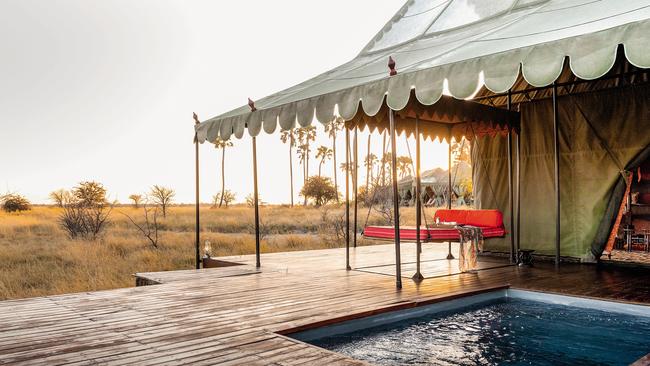
A box inlaid with porcupine quills contains the tea selection. We eat with silver cake forks and drink cool, sweet lemonade beneath framed vintage maps of Africa. Besides our conversation there’s only the sound of us eating and drinking. In between, nothing. Jack Bousfield fell in love with this quietness, Ntesang tells me. “It’s so quiet here sometimes you can hear your heartbeat, and it deafens your ears.”
My Botswana plans, like those of so many, were thwarted by the pandemic. I was meant to arrive here in 2020 for Jack’s grand reopening, but of course that never happened.
The revamped camp eventually opened in December 2021 and here I am, finally, in mid-2022. Languishing in my 270-square-metre floral-print pavilion with wilderness views. Jack’s nine tents tripled in size during the rebuild to excessive and quite astonishing dimensions. My teak pool deck alone is large enough to host a cocktail gathering for 80. The tents, reached via sandy paths edged with high grasses and mature trees for privacy, are fit for royalty.
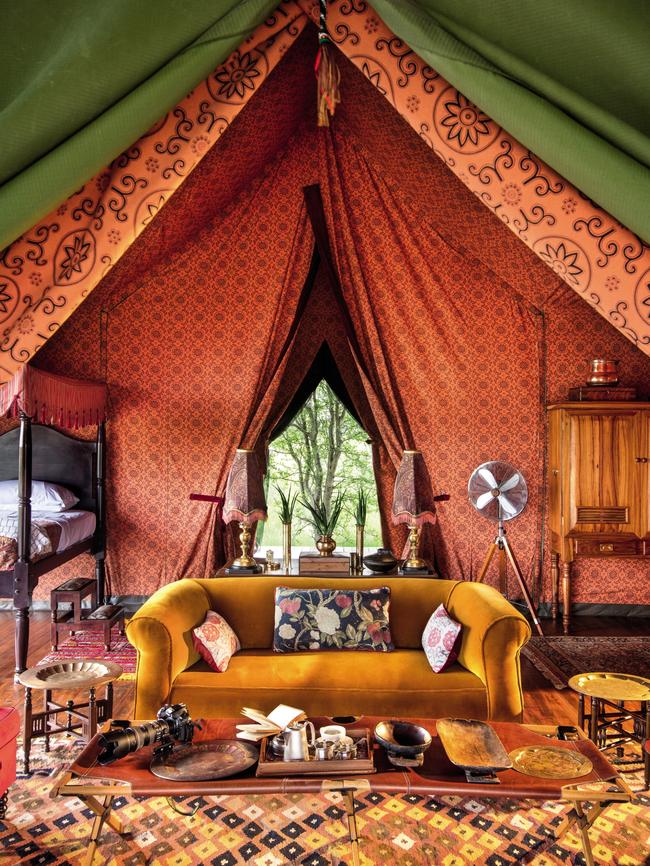
The handsome campaign furniture in timber and leather complements Persian and North African rugs, mahogany cabinets, ostrich feathers, velvet and upholstery, brass and marquetry. Air-cooled four-poster beds, two per suite, are decorated with bunting and bobbles. There are armchairs, chaises longues and two swinging daybeds on the deck that invite lazy afternoon daydreaming in warm breezes between dips in the plunge pool (also new).
There’s a wood-panelled shower, a thunderbox with pull-chain flush and twin marble vanities equipped with house toiletries from “moisturising liniment” to “undergarment solution” (in Africa one must wash one’s own smalls). Each suite also has a bar stocked with mixers, full bottles of whisky, gin and Amarula cream liqueur, local beers, and wines from South Africa’s Western Cape. The ice bucket is always, magically, full.
Days begin around dawn when Julia, my housekeeper, arrives with a cheery, musical, “Good morning! May I come in?” and leaves a cosied silver teapot and two fingers of shortbread on the coffee table. Red-billed spurfowl, the kookaburras of the Kalahari, chuckle in the trees outside. All meals are served in the mess tent, new and enlarged post-renovations, where guests sit at a 26-seat dining table amid a riot of heirlooms and objects.
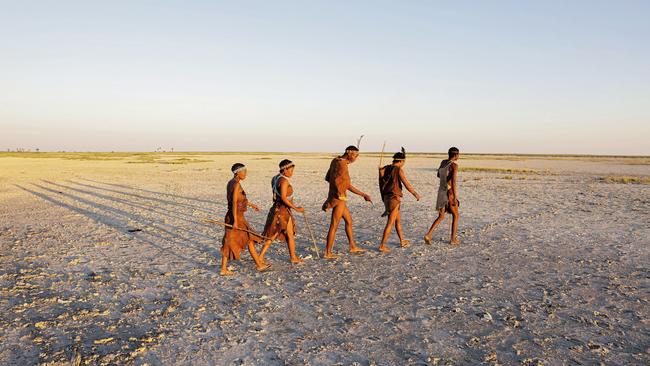
The Bousfields’ collection of artefacts, amassed over generations, is so significant the camp has been designated as one of Botswana’s official museums. Display cabinets contain everything from tribal jewellery to stone weapons and tools. Pottery fragments, fossils, anatomical drawings of animals, pickled creatures, skulls (animal and human), geological samples, teeth, tincture bottles and a “Complete Anti-Snake Venom Outfit”. More curiosities decorate every suite and public areas like the bar/games room with its antique pool table and generous liquor selection.
The effect is to create a distinctive and captivating aesthetic unmatched anywhere on the continent. Meals are hearty rather than haute. Dinner might be carrot, orange and ginger soup followed by (very good) chicken curry and a posset-like lemon cream. Served with Stellenbosch wines and a lively conversation about black mambas. There’s no Wi-Fi or phone reception so the waning art of conversation comes into its own again at Jack’s.
Breakfast, with plenty of cooked and fresh options, daily smoothies and camp-baked breads, is served around sunrise and then it’s off to explore. Morning and afternoon game drives, in comfortable open vehicles with rooftop seats, can last four hours or even all day if there’s enough action outdoors. Jack’s occupies a tiny corner of a million-acre private concession alongside sister properties Camp Kalahari, the affordable option, and beautiful San Camp right on the edge of the white wilderness.
All have access to the Belgium-sized, 30,000-square-kilometre salt pans, which include the neighbouring Makgadikgadi Pans National Park and Nxai Pan National Park, and the wildlife within. I spy cheetahs and elephants, adorable bat-eared foxes, owls, hornbills and, as luck would have it, the second-largest migration of zebras and wildebeest in the world.
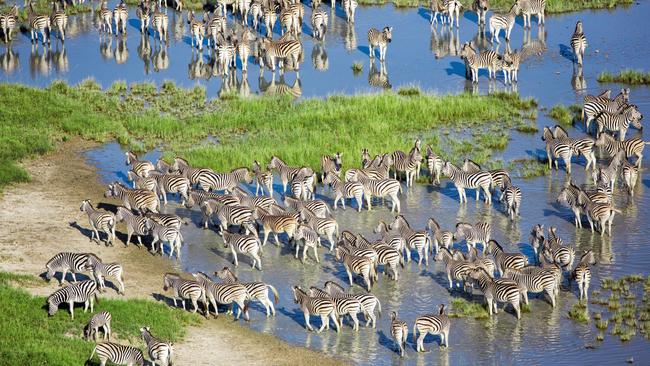
They usually arrive in their tens of thousands in the wet season at the start of each year, but the rains are late in 2022 so they’ve just arrived in April. On the first morning drive we’ve barely left camp when we’re wildly outnumbered by striped horses and maned antelopes on the palm-studded pastures of the Makgadikgadi.
A magnificent sight, but there’s one animal encounter here that trumps all others. The three camps share this concession with a colony of meerkats habituated to humans for research purposes. Meaning they’re still wild, but no longer see humans as a threat.
The advantages of this arrangement are that, once you’re seated on the ground, meerkats scale your arms and torso or even scramble on top of your head seeking vantage points from which to guard against their nemesis, the harpy eagle. I’m covered in critters and couldn’t be happier. Noisy eight-week-old pups complain constantly for food and then collapse on the back of my hand for a nap.
They’re feral but adorable and I envy keeper Reason Keonetse, who arrives daily at dawn to be here when the creatures wake and stays with them until they’re safely bedded down in burrows. “You know, these guys (like Reason) are so attached to the meerkats that if they come back to camp and haven’t been able to find them, there’s real pain in their eyes,” Chemical says.
Safaris, by their nature, bring joy and excitement to our lives. But few lodges can match Jack’s for the sheer breadth and wonder of what it offers. There are horseriding outings, and multi-day quad-bike excursions deep into the pans, to the Island of Lost Baobabs and sacred Kubu Island where guests camp overnight on stretchers and bed rolls.
And there are the Bushmen. Since Jack’s opened there’s always been a rotating group of Zu/’hoasi people who live on site and spend their days sharing culture with visitors from far away. For me, this is the greatest thrill. Booster takes me to meet the Bushmen one morning. As we’re walking through bush to their camp I ask if it’ll be okay to take photos. “They love photos,” Booster smiles. “They are quite photogenic.”
I’m greeted by big grins and antelope skins as each member of the group gathers to shake my hand and introduce themselves. Khanxa announces himself as the interpreter and proceeds to demonstrate the five click sounds, or vowels, of their language.
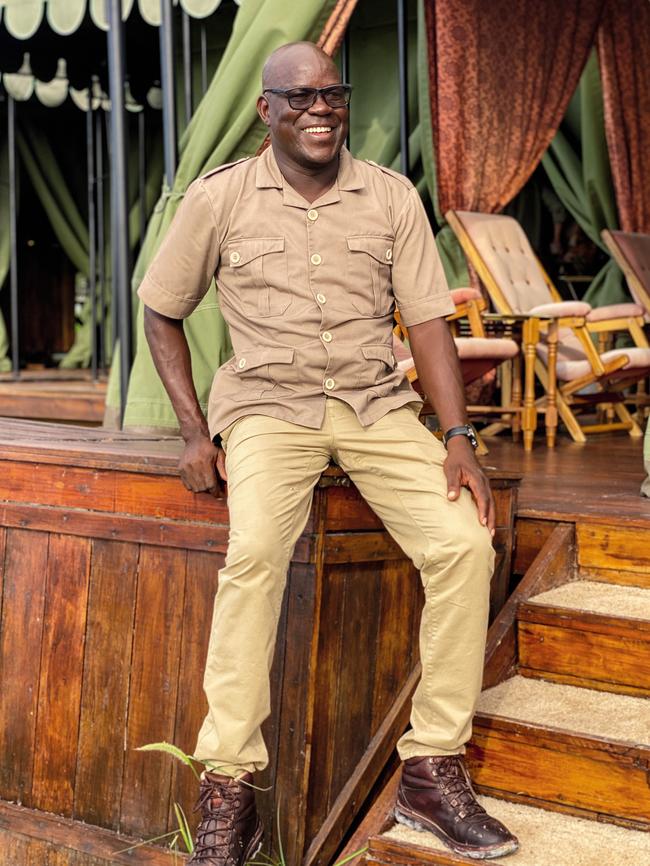
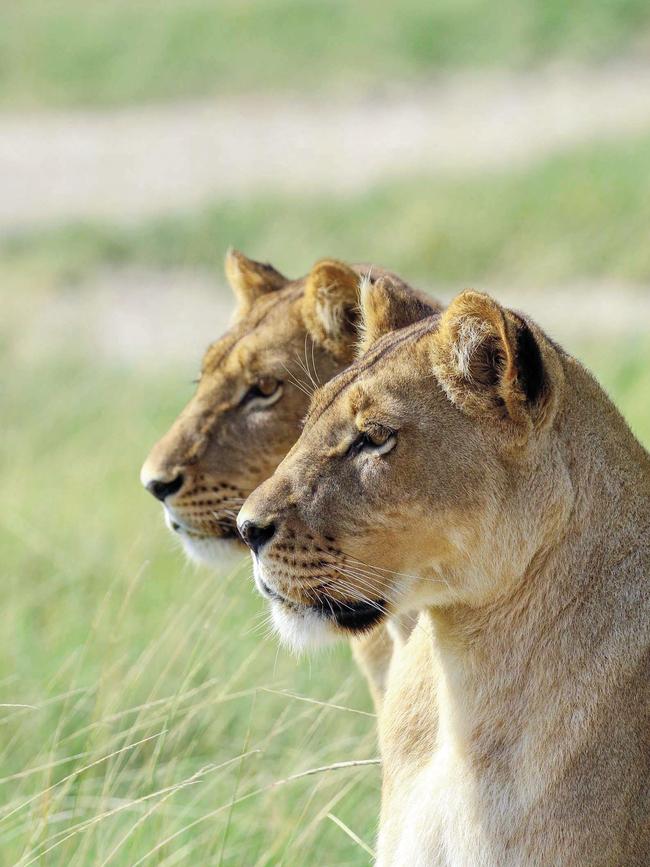
He tells me they come from a village called Xaxa, some 600 kilometres away up near the Namibian border. The Bushmen used to be nomadic, following the migration of animals and foraging wild fruits, so they know this land better than anyone. I learn so much during our walk together – about the medicinal and nutritional value of various plants, the correct handling procedures for scorpions, and how to start a fire with two sticks. I also learn that the Zu/’hoasi are very, very funny. Khanxa’s impersonation of a defecating elephant is gloriously vulgar.
Towards the end of our time the group sits on the prairie grasses and makes a small fire. Rollies are lit from the flames. The men start a game of Steenbok and Lightning, which involves two teams doing rapid-fire hand movements, like Rock-Paper-Scissors, while singing and sledging. It’s a song, a game, a mantra.
Women and men sit behind clapping and singing as the kneeling players use their upper bodies to compete for dominance. Lightning wins by 26 points, amid gales of laughter. “We only play this game when we’re happy,” Khanxa smiles. On the eve of my departure, Jack’s has one final breathtaking trick.
After a visit to San Camp, where a honeymooning couple watched a lion cross the pan not 50 metres away two nights ago, a helicopter arrives. Jack’s reopened with a permanent chopper and pilot on site so aerial tours are relatively cheap (about $US260 per person) and easily accessible.
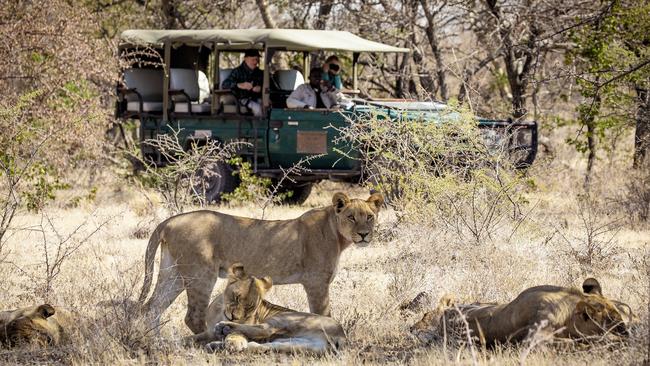
There’s a spare seat; pilot Hugh asks if I’d like to come up for a “flip” (pilot speak for a scenic flight). There is only one possible answer. It’s not until you’re in the air looking down on the vast void that you truly appreciate there is Nothing. Else. Here. But the pans are far from desolate. The Earth’s surface shimmers in lakes and pools tinged red with algae and pale blue with reflected sky.
An island of pink erupts into the air as a cloud of flamingoes takes flight. Colossal herds of zebra and wildebeest cast long, ungulate shadows in the glowing sunlight. “If we kept flying now for an hour we’d keep seeing zebra and wildebeest,” Hugh says over the mic. “That’s how many there are.”
Buzzing with exhilaration, we come back to Earth on the pan edge where Chemical and Booster await with wide grins and a wonderful surprise. Behind them vintage timber trunks have been arranged into a well-stocked cocktail bar. In front, a fire crackles and flares. The only thing missing is a Negroni.
Neither guide knows how to make one – a rare failing at Jack’s – but no matter. I can mix one blindfolded. We sip and snack while Chemical unrolls a map of Botswana. Time for a prehistory lesson. He takes us back 200,000 years to when Makgadikgadi was an enormous lake extending over 200,000 square kilometres and 300 metres deep in parts.
The last light fades and only flames illuminate his face as Chemical describes the lushness and abundance that once thrived here and how, according to updated theories of human evolution based on DNA research, there’s a fair chance the first Homo sapiens emerged from this very spot. “You don’t come from Australia,” he laughs. “You come from here. Welcome home.”
The writer’s ground arrangements were handled by Bench Africa. Bench Africa offers three-night stays at Jack’s Camp from $7,765 per person dual occupancy, including meals and local drinks, return scheduled flights from Maun, game drives and park entrance fees. benchafrica.com



To join the conversation, please log in. Don't have an account? Register
Join the conversation, you are commenting as Logout